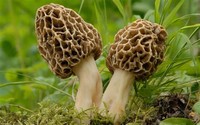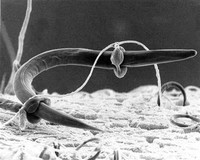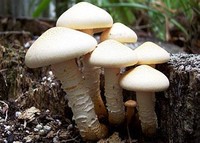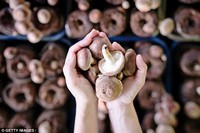Facts about Fungi

Fungi's mutualistic symbiotic relationship with other organisms and most land plants is reflective of an underlying harmony in biological interactions and the universal principle of bi-level functionality.

Fungi (singular fungus) make up one of the kingdoms into which living things are divided by biologists.

Molds, like all fungi, need moisture to grow, so the best way to prevent damage from them is too avoid dampness.

The plant provides the fungi with nutrients produced by its photosynthesis.

Most plants could not thrive without a partnership with these fungi.

Some species have been used as biological controls for pests, taking advantage of the fungi's own natural defenses against bacteria, insects, worms, and other fungi.

The major divisions (phyla) of fungi are mainly classified based on their sexual reproductive structures.

Some fungi form rhizoids, which are underground, root-like structures that provide support and transport nutrients from the soil to the rest of the mycelium.

Other fungi may live in mutually beneficial symbiotic relationships (mutualism) with other organisms.

Fungi differ from bacteria in having a cell nucleus; from plants in not making their own food through photosynthesis; and from animals in not being mobile and in absorbing nutrition externally rather than internally.

Some fungi are predators of nematodes, which they capture using an array of devices such as constricting rings or adhesive nets.

Truffles are the underground fruiting bodies of several species of fungi that live in a mycorrhizal relationship with the roots of oak trees.

Other fungi form symbiotic relationships with other plants and animals, whether this close association is beneficial or harmful to the other organisms.

Yeasts and other unicellular fungi can reproduce simply by budding, or “pinching off” a new cell.

Molds are various types of fungi that decompose dead plant and animal material.

Much research is going on worldwide into fungi and their possible benefits to humankind.

The Deuteromycota is a sort of miscellaneous junk category for forms of fungi of uncertain affinity, and include those fungi in which sexual reproduction is unknown.

Fungi are the primary decomposers of dead plant and animal matter in many ecosystems, and are commonly seen on old bread as mold.

Sexual reproduction has not been observed in some fungi of the Glomeromycota and Ascomycota.

Multicellular fungi are composed of networks of long hollow tubes called hyphae.
Fungi can be single celled or very complex multicellular organisms. They are found in just about any habitat but most live on the land, mainly in soil or on plant material rather than in sea or fresh water.
A fungus (plural: fungi) is a kind of living organism: yeasts, moulds and mushrooms are types of fungi. The fungi are a separate kingdom of living things, different from animals and plants. Fungi have cells with nuclei. Their cell walls contain chitin, unlike the cell walls of plants, which contain cellulose.
Fungi grow everywhere! They cannot make food by themselves so they have to have to get their nutrients from a host. They grow on lots of different hosts, anywhere that is warm and damp. Fungi can't move around so they make spores that are like seeds.
Harmful fungi in both agriculture and medicine. Most fungi are saprophytic and not pathogenic to plants, animals and humans. However, a relative few fungal species are phytopathogenic, cause disease (e.g., infections, allergies) in man, and produce toxins that affect plants, animals and humans.
Fungi can be good to eat, like some mushrooms or foods made from yeast, like bread or soy sauce. ... Scientists use fungi to make antibiotics, which doctors sometimes use to treat bacterial infections. Fungi also help to decompose lots of different organic material, from leaves to insects!
Fungi play vital roles in the biosphere. They are essential to the recycling of nutrients in all terrestrial habitats because they are the dominant decomposers of the complex components of plant debris, such as cellulose and lignin.
Fungi are useful to humans because they have economic value. Some fungi, such as mushrooms and truffles, are eaten directly, and others are used to produce things of value. ... Fungi are very important ecologically, because they are one of the most important decomposers in most ecosystems.
Humans have collected and grown mushrooms for food for thousands of years. Figure below shows some of the many types of mushrooms that people eat. Yeasts are used in bread baking and brewing alcoholic beverages. Other fungi are used in fermenting a wide variety of foods, including soy sauce, tempeh, and cheeses.Feb 24, 2012
Most fungi are not dangerous, but some types can be harmful to health.Aspergillosis. Caused by the fungus Aspergillus and usually occurs in people with lung diseases or weakened immune systems.Candidiasis. Caused by the yeast Candida. ... Fungal eye infections. Different types of fungi can cause eye infections. ... Ringworm.
In an ecosystem, fungi play the role of decomposers -- they break down dead organic matter and return vital nutrients to the soil. Without fungi, nutrients would not cycle through an ecosystem, causing the breakdown of the entire food chain.Apr 25, 2017




